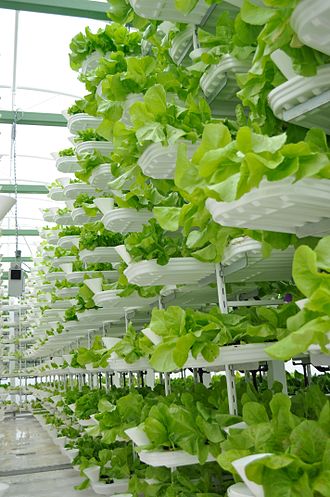Vertical farming

Vertical farming is the practice of growing crops in vertically stacked layers. It often incorporates controlled-environment agriculture, which aims to optimize plant growth, and soilless farming techniques such as hydroponics, aquaponics, and aeroponics. Some common structures used for vertical farming include buildings, shipping containers, tunnels, and abandoned mine shafts.
History[edit]
The concept of vertical farming was first proposed by Gilbert Ellis Bailey in 1915. However, the modern concept of vertical farming was popularized by Dickson Despommier, a professor of public health at Columbia University, in 1999. Despommier and his students proposed that vertical farming could be a solution to the problems of urban food production and sustainability.
Techniques[edit]
Vertical farming employs several innovative techniques to maximize yield and efficiency:
- Hydroponics: A method of growing plants without soil by using mineral nutrient solutions in an aqueous solvent.
- Aquaponics: A system that combines conventional aquaculture (raising aquatic animals such as fish) with hydroponics.
- Aeroponics: A process of growing plants in an air or mist environment without the use of soil or an aggregate medium.
Advantages[edit]
Vertical farming offers several advantages over traditional farming methods:
- Space Efficiency: By stacking layers of crops, vertical farming uses significantly less land.
- Water Conservation: Vertical farms can use up to 70% less water than traditional farms.
- Reduced Transportation Costs: Growing food in urban areas reduces the need for transportation, lowering costs and carbon emissions.
- Year-Round Production: Controlled environments allow for continuous crop production regardless of external weather conditions.
Challenges[edit]
Despite its advantages, vertical farming faces several challenges:
- High Initial Costs: The setup costs for vertical farming systems can be prohibitively high.
- Energy Consumption: The need for artificial lighting and climate control can result in high energy usage.
- Technical Expertise: Successful vertical farming requires specialized knowledge and skills.
Applications[edit]
Vertical farming is used in various applications, including:
- Urban Agriculture: Growing food in urban areas to reduce food deserts and increase local food production.
- Research and Development: Studying plant growth in controlled environments to improve agricultural practices.
- Commercial Production: Producing high-value crops such as leafy greens and herbs for sale in local markets.
Future Prospects[edit]
The future of vertical farming looks promising with advancements in technology and increasing interest in sustainable agriculture. Innovations in LED lighting, automation, and artificial intelligence are expected to further enhance the efficiency and viability of vertical farming.
Related Pages[edit]
- Hydroponics
- Aquaponics
- Aeroponics
- Urban agriculture
- Sustainable agriculture
- Controlled-environment agriculture

This article is a agriculture stub. You can help WikiMD by expanding it!
Ad. Transform your life with W8MD's Budget GLP-1 injections from $75


W8MD offers a medical weight loss program to lose weight in Philadelphia. Our physician-supervised medical weight loss provides:
- Weight loss injections in NYC (generic and brand names):
- Zepbound / Mounjaro, Wegovy / Ozempic, Saxenda
- Most insurances accepted or discounted self-pay rates. We will obtain insurance prior authorizations if needed.
- Generic GLP1 weight loss injections from $75 for the starting dose.
- Also offer prescription weight loss medications including Phentermine, Qsymia, Diethylpropion, Contrave etc.
NYC weight loss doctor appointmentsNYC weight loss doctor appointments
Start your NYC weight loss journey today at our NYC medical weight loss and Philadelphia medical weight loss clinics.
- Call 718-946-5500 to lose weight in NYC or for medical weight loss in Philadelphia 215-676-2334.
- Tags:NYC medical weight loss, Philadelphia lose weight Zepbound NYC, Budget GLP1 weight loss injections, Wegovy Philadelphia, Wegovy NYC, Philadelphia medical weight loss, Brookly weight loss and Wegovy NYC
|
WikiMD's Wellness Encyclopedia |
| Let Food Be Thy Medicine Medicine Thy Food - Hippocrates |
Medical Disclaimer: WikiMD is not a substitute for professional medical advice. The information on WikiMD is provided as an information resource only, may be incorrect, outdated or misleading, and is not to be used or relied on for any diagnostic or treatment purposes. Please consult your health care provider before making any healthcare decisions or for guidance about a specific medical condition. WikiMD expressly disclaims responsibility, and shall have no liability, for any damages, loss, injury, or liability whatsoever suffered as a result of your reliance on the information contained in this site. By visiting this site you agree to the foregoing terms and conditions, which may from time to time be changed or supplemented by WikiMD. If you do not agree to the foregoing terms and conditions, you should not enter or use this site. See full disclaimer.
Credits:Most images are courtesy of Wikimedia commons, and templates, categories Wikipedia, licensed under CC BY SA or similar.
Translate this page: - East Asian
中文,
日本,
한국어,
South Asian
हिन्दी,
தமிழ்,
తెలుగు,
Urdu,
ಕನ್ನಡ,
Southeast Asian
Indonesian,
Vietnamese,
Thai,
မြန်မာဘာသာ,
বাংলা
European
español,
Deutsch,
français,
Greek,
português do Brasil,
polski,
română,
русский,
Nederlands,
norsk,
svenska,
suomi,
Italian
Middle Eastern & African
عربى,
Turkish,
Persian,
Hebrew,
Afrikaans,
isiZulu,
Kiswahili,
Other
Bulgarian,
Hungarian,
Czech,
Swedish,
മലയാളം,
मराठी,
ਪੰਜਾਬੀ,
ગુજરાતી,
Portuguese,
Ukrainian